Paddleboarding is taking the world by storm and the fact you have landed on this article would suggest you are ready to jump on board and get involved with this wonderful activity.
Paddleboarding can be done on just about any body of water be that rivers, lakes, bays or the ocean, paddleboarding offers you a great way to experience all the wonders that our beautiful water roads have to offer.
Aside from offering a view of the world that is different to the norm, stand up paddleboarding is also a full body workout.
One of the main reasons why paddleboarding has become so popular in recent years is because it removes the barrier of entry that stops most people jumping in the water.
It can be done by all people regardless of age, shape and size.
In fact it can be done by more than just people, as I am sure you would have seen by now, all the pictures of the dogs that are tagging along for the journey on the front of their owners boards.
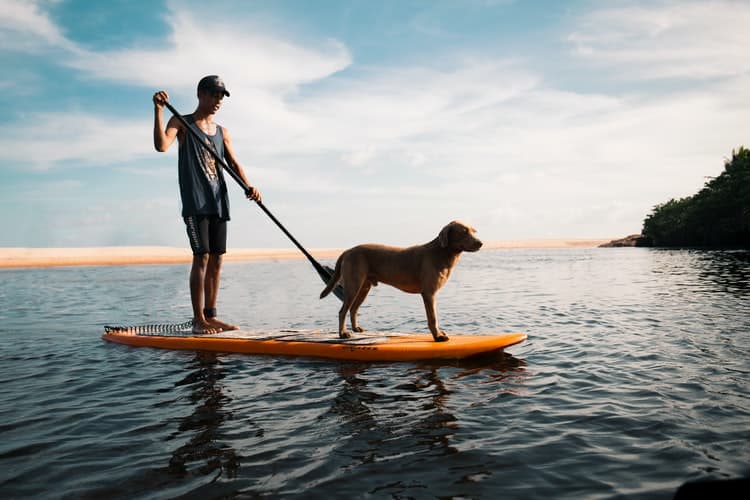
The point is Paddleboarding is a fantastic activity that you can do with the whole family, on your own or with your pets.
Getting into paddleboarding can seem rather daunting as there are so many different types of boards, different accessories and then there is the added task of not only standing up on the board but paddling yourself along whilst standing up.
In this article I am hoping to cover all the basics relating to paddleboarding so when you finally jump on board (Excuse the pun) you don’t feel confused or overwhelmed by the whole experience.
The topics covered in this article are as follows:
- Different types of Paddleboard constructions and Designs
- Different Paddle Types and What Size Paddle You need
- How to Stand Up On a Paddleboard
- Paddling Technique
- How and Where To Practice
Different Types Of Stand Up Paddleboards
The first thing we need to cover is what different paddleboards there are and which one you will most likely want to start with.
I can see why this would be confusing and maybe even intimidating to newcomers to the activity/ sport.
Not only is there a whole host of different shapes and sizes there are even boards that are constructed of completely different materials.
The most common board type is the traditional Epoxy Board or hardtop board, these are similar to surfboards in that they are often constructed using EPS Foam that is then wrapped in epoxy resin and fiberglass.

The next board type is the soft top board, these are often constructed in the same way as the hardtop boards but they are wrapped in a spongy soft foam shell to protect the user and other people in close proximity.
The soft top board is great for beginners, children and those who like to bring pets along with them on their journeys.
The last type of board which only came to the market in 2014 is taking the paddleboard industry by storm and that is the inflatable paddleboard range.
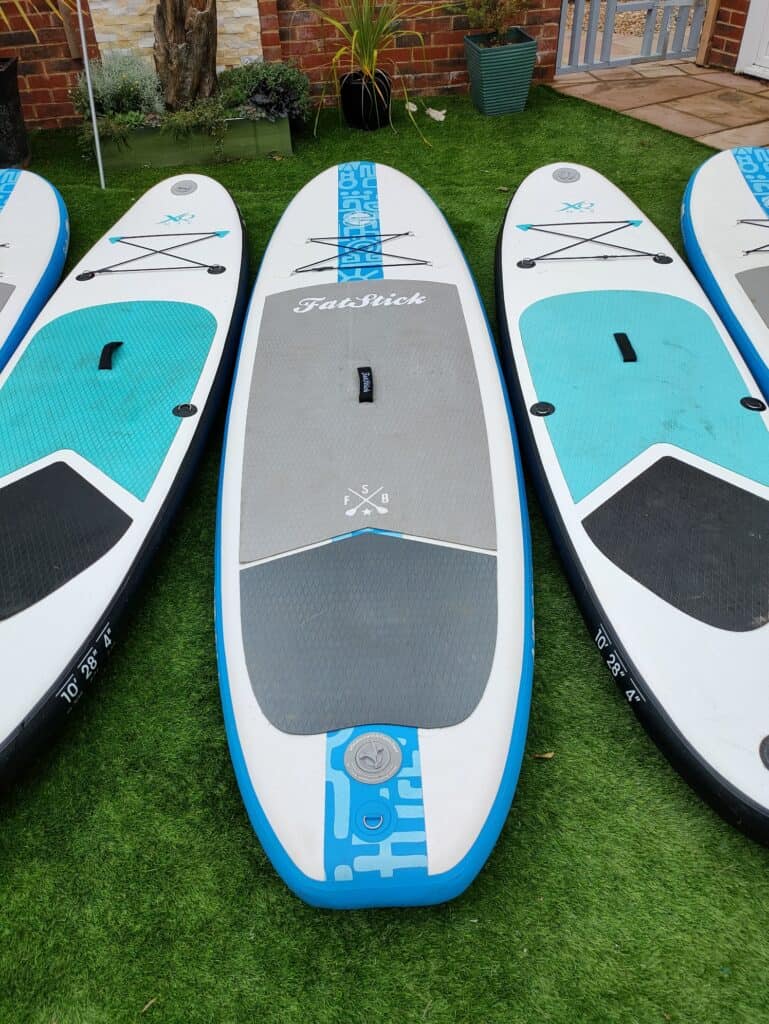
When inflatable paddle boards first arrived on the market they were certainly more geared towards the recreational paddleboarder, however, with innovative designs and new technology, each year inflatable paddle boards are becoming the go to boards for many other paddleboarding activities such as SUP surfing, SUP Touring and even SUP Racing.
Each of these paddleboard construction types offer different benefits and are intended for different purposes.
Epoxy (Hard Top) Stand Up Paddleboards
Epoxy stand up paddleboards are most similar to traditional surfboards so these are the perfect boards for those who are used to hardtop boards.
Generally speaking Epoxy boards are able to be designed with performance in mind so regardless of what variation of paddleboarding you are looking to do you will find the right board for you in a hardtop variety.
The downside to hardtop boards is that they are rigid and therefore require you to have somewhere to store it and if you aren’t lucky enough to live within walking distance of a body of water, you will also need some way of transporting it.
Soft Top Stand Up Paddleboards
Soft top stand up paddle boards offer the vast majority of benefits that you get with the epoxy boards but they offer these benefits wrapped up in a nice soft shell.
Soft tops are great for beginners and kids as they allow them to jump on the boards without being too worried about getting hit or landing harshly on the board.
Soft tops are also great if you plan on taking pets out with you as the foam tends to be grippier for the animals so they don’t start sliding around when the board gets wet.
Soft tops do sacrifice speed over their epoxy cousins as the water slowly gets absorbed into the foam which increases the drag in the water.
These boards also suffer from the same issue as the soft tops, that being you need somewhere to store them and a way of transporting them.
Inflatable Paddleboards
Inflatable paddleboards are definitely my favourite boards, not only have them been so cleverly tampered with that you can an inflatable sup for just about all aspects of paddleboarding now but they are extremely convenient thanks to the fact they can be deflated, rolled up and thrown in the back of the car taking up no more room than a sleeping bag.
Inflatable paddleboards are constructed of a rubber compound which is very strong yet soft and forgiving should the board bounce back and bump into you when you fall off.
Inflatable paddleboards are suitable for all users and really offer very little downside.
If you are after penultimate performance then firstly you are probably reading the wrong article, but secondly you will probably want to look at the hardtop options.
Even though inflatable paddleboards are getting more and more intelligent each day they still can’t compete with the very best performance boards in the epoxy category.
Although watch this space as the inflatable paddleboard game is ever evolving.
Different Boards for Different Activities.
Now we have covered the different construction types of paddleboards you may have seen me mentioning things such as SUP surfing, SUP touring and SUP Racing.
As the sport of paddleboarding evolves so to does the limitless possibilities of what is achievable on a paddleboard.
As different paddleboarding activities have increased in popularity, the manufacturers of these boards have seen fit to design specific boards to suit specific activities.
So just what are each of these paddleboarding activities and what do the boards look like for each activity?
SUP Surfing
SUP surfing iis where you use a stand up paddleboard to surf rather than a traditional surfboard. You catch waves by being stood up on the board and paddling yourself in the waves. Once on the wave you can switch a surf stance and ride the wave all the way.
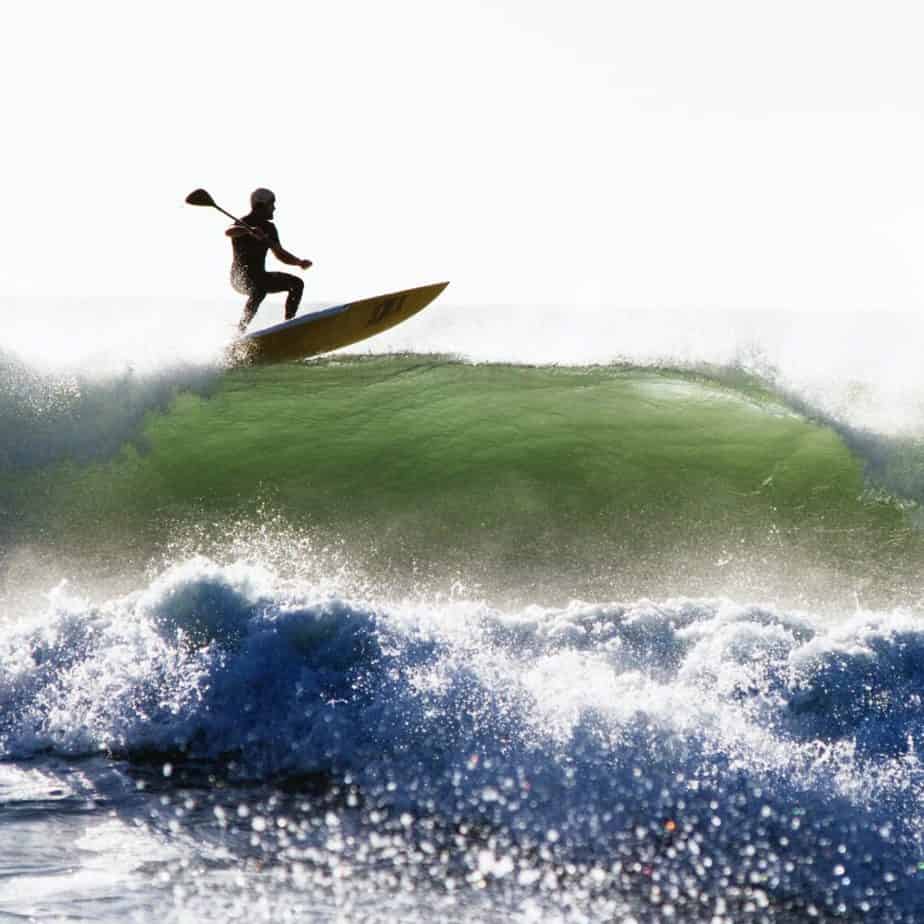
This sort of paddleboarding is particularly popular with surfers who live in an area where swells are often small as the added length and volume allows them to catch smaller waves and they can still get a good workout in if the swell drops off.
It is also commonly adopted by older people who love surfing but maybe now struggle to pop up from a traditional surfboard.
SUP Surf Boards are commonly smaller, usually between the ranges of 8’6” – 10’6”, they also tend to have more rounded noses and a tapered tail, this allows the paddleboarder to ride over the whitewater when paddling out as well as the ability to perform noserides etc.. when surfing in.
SUP Touring
SUP Touring is where you use your paddleboard to go on long distance paddles often at a consistent pace with little to no stops, this type of paddleboarding is fantastic exercise but also allows you to enjoy the coastal scenery as you embark on your adventure.
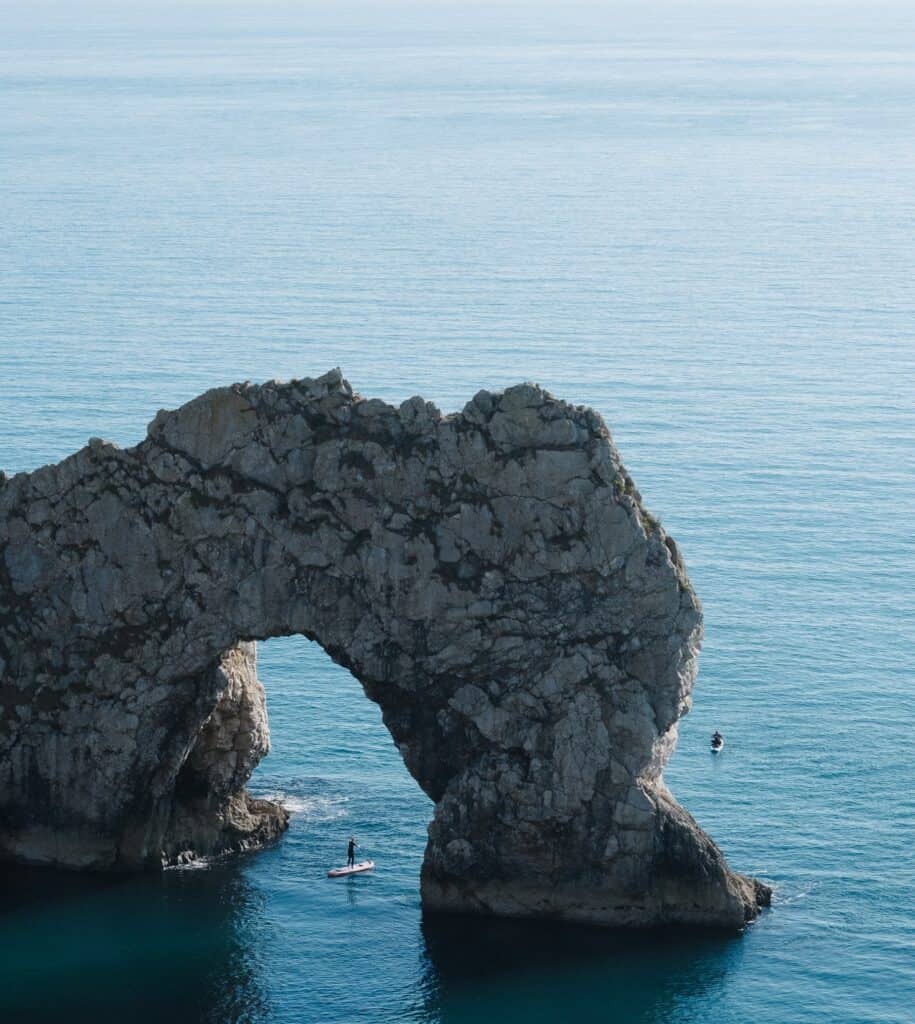
If it was to be compared to traditional sporting activities it would be similar to long distance running.
Touring SUPS are traditionally not as wide and have a pointed nose, this allows the board to cut through the water with great efficiency and reduces drag from the board. These boards are typically more tricky for beginners to get on with as they are quite narrow.
SUP Racing
SUP Racing is normally done in a competitive format in which paddleboarders set off from a starting point and have a finishing line.
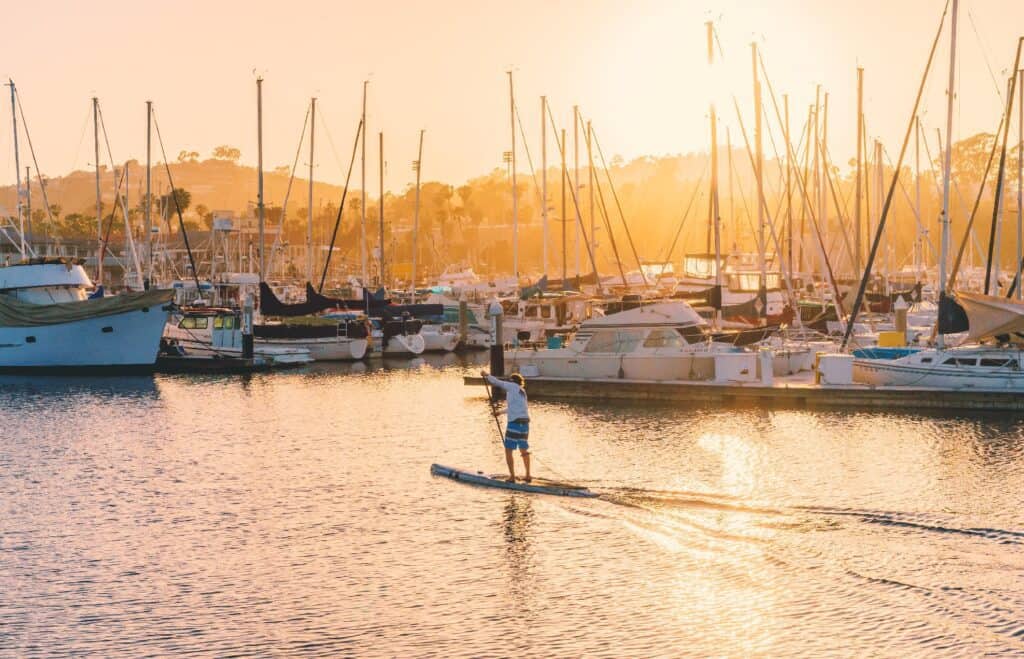
SUP Racing is the most physically demanding type of Stand up paddleboarding as you are often trying to keep a very fast consistent pace throughout a whole race which are often not short with one of the most common distances being 5km
SUP racing boards are often the longest boards available, they again are very narrow with pointed nose and tail.
These boards are designed to be as hydrodynamic as possible to cut through the water and maintain speed when gliding.
These boards are a cut above all other boards when it comes to difficulty for beginners.
Due to the narrow widths and sharp edges these boards are very unstable unless ridden by an experienced rider.
All-Rounder
Now there is actually another type of board which I didn’t know in the opener of this paragraph and that is the all-rounder.
The all-rounder is a board that is not set up for any specific activity but is built to be used in any capacity the rider wishes.

Now by no means does this mean it will be great for racing or surfing but it certainly can be used for this activities.
The all-rounder boards are a fantastic choice for nearly all beginners as it keeps things simple,.
All-rounder boards are generally quite wide for better stability on the water and they often have increased volume to ensure they are buoyant.
These boards are generally designed to be used by the casual paddleboarders or beginners.
If I was to point you in any direction about which board you should learn on it would definitely be one of the all-rounders.
Different Paddles and What Size Paddle Do You Need?
Paddles come in a variety of shapes, sizes and materials.
When I say that paddleboard paddles come in a variety of materials I really am not kidding.
Paddles can be made of any of or even a combination of the below noted materials:
- Wood
- Plastic
- Aluminium
- Nylon
- Fiberglass
- Carbon Fiber
Each of these materials offers a different benefit as well as a greatly different price tag.
Wooden Paddles
Now it is true that wooden paddles are by far the most traditional and authentic looking paddles.
If you want to get back in touch with your roots then a wooden paddle is definitely the way to go.
If you are really passionate about wooden paddles then I strongly suggest you check out Otter Surfboards.
Simply click on the picture to check out Otter Surfboards.
Despite the looks though a wooden paddle doesn’t offer many other benefits when compared to the other materials, The wood is heavy when subdued in water and also requires a great deal of maintenance and upkeep to keep the paddle in good shape.
Plastic Paddles
Plastic paddles are light and cheap and often only used for children.
The plastic although perfectly acceptable for younger children is not very strong and subsequently tends to bend and break when used by adults.
Aluminium Paddles
Aluminium is a strong, reliable but cheap material and therefore is often used when making entry level paddles to be sold off as packages with paddleboard starter kits.

Aluminium if often paired with plastic to create a reliable yet affordable paddle.
Nylon
Nylon is a special type of plastic that is much stronger and therefore much better at taking a beating.
These types of paddles are fantastic for beginners and experienced paddlers as they offer a lot of the benefits that carbon and fiberglass offer whilst being better at taking bashes and bumps in its stride.
Fiberglass
Fiberglass paddles are very much the midtier category of paddles.
Fiberglass is a very rigid material which improves which makes strokes more efficient thus reducing paddle fatigue.
Fiberglass although being very rigid is not as sturdy as Carbon Fiber, this is why it is priced accordingly.
Carbon Fiber
Carbon Fiber paddles are the strongest and most rigid paddles on the market. The strong rigidity of the paddle makes performing strong powerful strokes effortless.
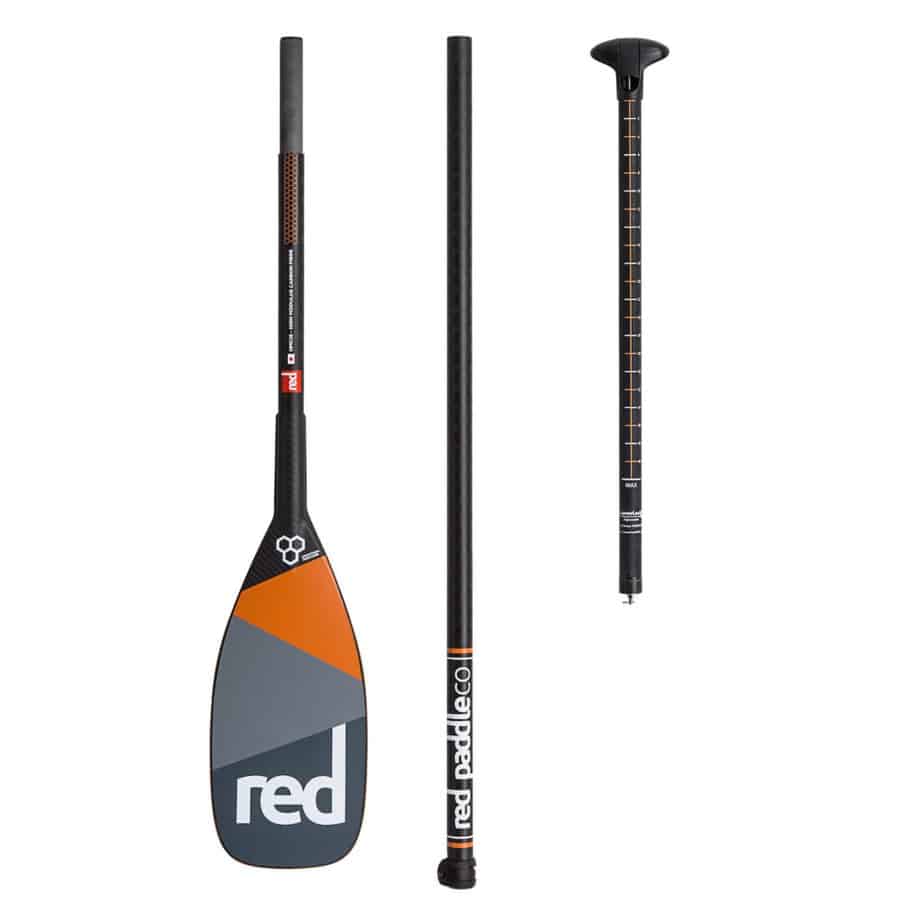
Carbon Fiber is also extremely light making it a great material for paddles.
If you want to see my recommended paddle of choice, you can head over to my recommended gear page to check out my latest pick.
Paddle Shafts
Now we have covered the different materials that paddles are available in.
It is time to discuss the different paddle shafts you will encounter.
There are a couple of different options when it comes to paddle shafts.
There is the fixed length paddle which is a solid paddle in which the blade, shaft and handle are all connected and joined together.
The second option is the adjustable paddles that are usually 3 piece paddles, this means the blade, shaft and handle come in three separate sections.
The blade and shaft clip or lock together and then handle is locked at the required height to suit the paddleboarders needs.
Adjustable paddles are a fantastic tool that allow multiple people to use them and also individual paddlers to determine which length paddle works best for them.
What Size Paddle Do You need
Now you know the different paddle materials and the different shaft options you obviously need to know what size paddle you will need for when you get out on the water.
For the most part the paddle size you need is determined by your height and also what activity you are doing.
To determine what size paddle you need you can use the below table.
| SUP Activity | Inches Above Your Head Height |
| Recreational Paddling | 6”-10” |
| SUP Touring | 8”-12” |
| SUP Racing | 8”-12” |
| SUP Surfing | 4”-8” |
If you are a beginner looking to get into paddleboarding I would suggest you stick to recreational paddling to start with, with this in mind you will want to make your paddle 6-10 inches taller than your head height.
How To Stand Up On a Paddleboard
So we have now covered all the nitty gritty bits you should know before diving in and attempting paddleboarding.
Now it’s time for the fun part, how you actually stand up on your paddleboard and what stance you should maintain for optimum balance.
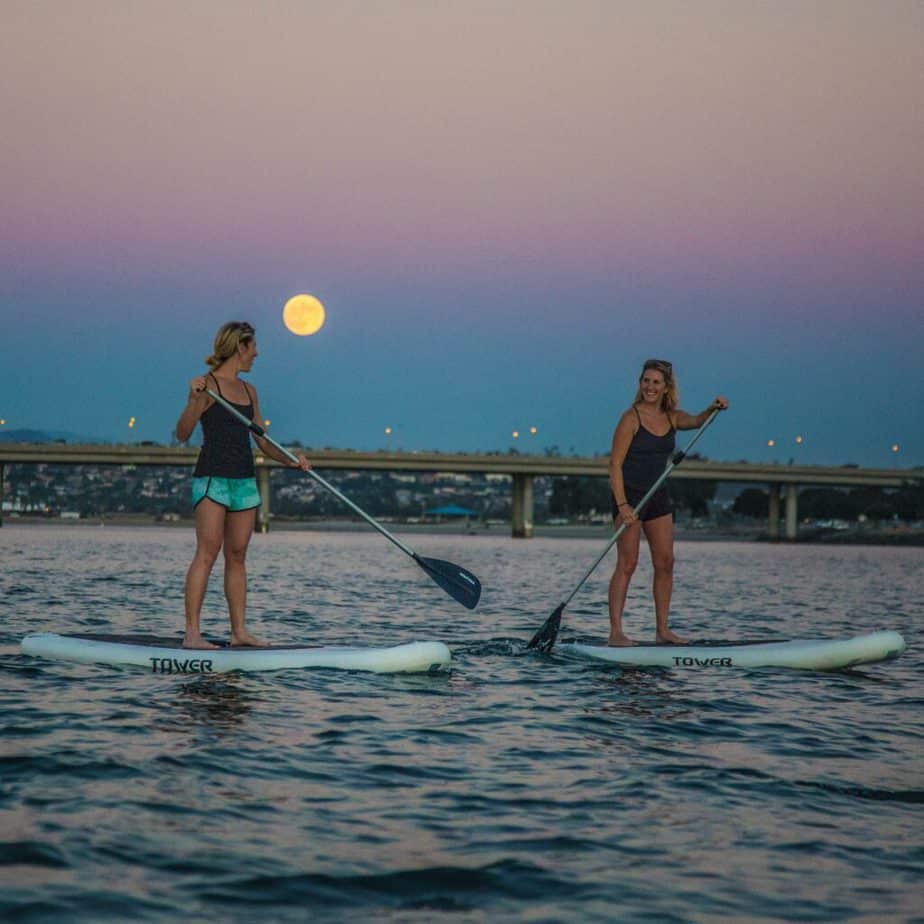
When you have found yourself a nice calm section of flat water and you are with your paddle with your paddle in we can start learning how to stand up.,
The first thing you will want to do is mount your board and then get to your knees.
Once you are kneeling on your board, using your paddle, carry out a few strokes to build up some momentum.
Once you start drifting along, attempt to stand up one leg at a time, start by placing your paddle horizontal and placing your hands with the paddle down on the board, take one leg and lift your knee so that you can plant your foot on the board.
Once you have one foot planted on your board, shift your weight onto this foot and push upwards to get ready for a standing position, as you push off your foot, take your other leg (that was still kneeling) and place this foot down.
You will now be standing on your board.
When you are standing up you ideally want to try and stand in the centre of the board with your feet just over shoulder width apart.
One useful way of finding the centre of the board when standing up is to use the carry handle as your point of reference.
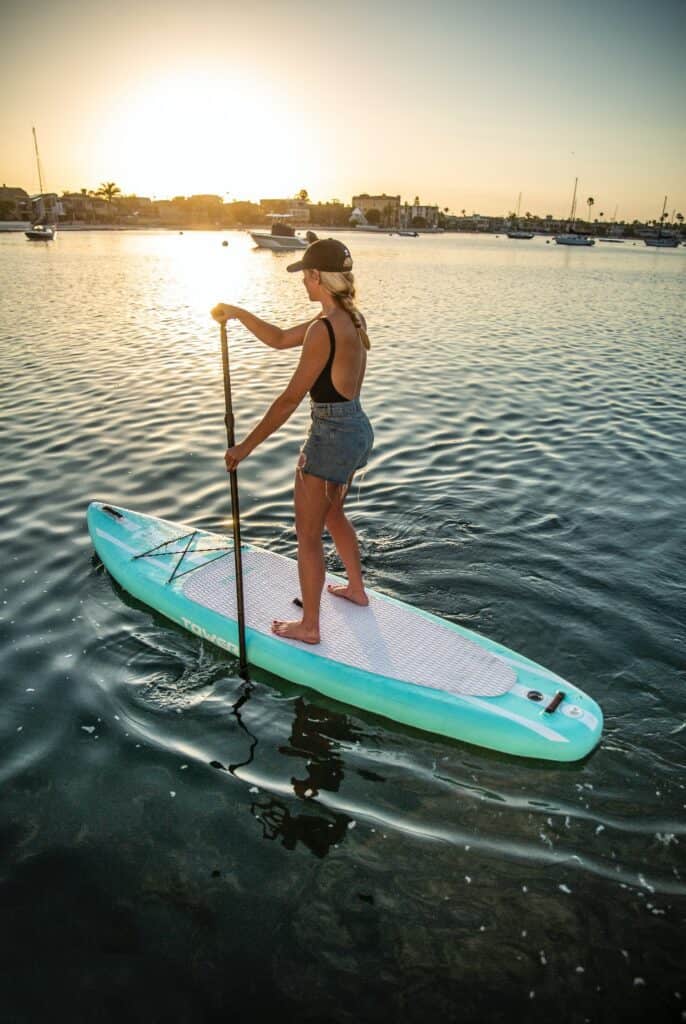
Once you are standing up and in the correct position we want to get into the correct stance to offer us the optimum amount of balance.
The correct stance will feel a little bit strange at first but trust me it works wonders and ensuring you remain balanced.
When in the standing position we want to put a slight bend in our knees and ensure our core remains in the centre of our body line.
By keeping our centre of gravity in the middle and putting a slight bend in our knees it allows our upperbody to stay straight and free of movement whilst our legs make micro adjustments to contend with the ripples, waves and whitewater of the water.
Paddling Technique
Now we are up on our feet and raring to go it is important we learn the correct paddling technique in the early stages as this will prevent us forming bad habits later down the line.
Having the correct stroke not only makes each paddle more efficient making us go faster while exerting less energy but it also helps us to reduce repetitive injuries from forced unnatural motions.
To hold the paddle we want to have one hand on the handle section and one hand approximately a ¼ of the way down the paddle.
Depending on which side of your body you are paddling will dictate which hand is on the handle and which hand is lower.
If you are paddling on the left side of your body, your right hand would be on the handle and vice versa if you were paddling on the right side.
When you have your hands sorted out it is important to ensure the paddle is facing the correct direction.
Many people think the blade (Bottom section) of the paddle should be angled backwards however the opposite is true, I can see why people may think this is the case as you would think having it angled backwards would allow you to pull harder through the water.

However, by angling the paddle this way you actually stop your stroke short, having the blade angled outwards allows you to reach further into your stroke which means you can pull much further thus making your strokes more efficient.
Make sure your blade is angled outwards (away from you).
We are now ready to start practicing paddling.
Straight Paddle Technique
Using your lower arm as a pivot point you want to try and keep this relatively straight and still throughout the paddling motion.
Pull your top hand towards your body to force the bottom of the paddle and the blade outwards.
Using the rotation of your shoulder in which your hand is currently holding the handle, reach as far forward as you can without leaving your centre of gravity and place the blade into the water.
Drive the blade deep into the water, ideally so you can no longer see the blade portion of your paddle.
Drive through your stroke using your top hand, pulling the paddle towards and then past your bodyline until the pendulum of your body brings the paddle back out the water.

As the paddle comes out the water, lift the paddle up back towards your centre and repeat the process.
To ensure you paddle in a straight line and not round in circles you will want to carry out a few strokes on one side of your body and then switch to the other side.
I normally recommend 2-3 strokes each side.
Turning Technique
There are actually two different ways in which you can quickly turn a paddleboard and it all comes down to whether you are moving or relatively still.
If you are moving you can dig your paddle into the water into the water near the tail of the board on the side you wish to turn, turn your torso to face the same direction and the momentum you had should turn you and your body round in the desired direction.
If you are still or reality still and wish to turn around you can use a reverse stroke to turn your board in the desired direction.
Place the blade into the water by the tail of the board on the side you wish to turn, pulling your blade towards the nose of the board you should notice your board will begin to turn in the desired direction, again be sure to turn your torso slightly with the turn to avoid becoming unbalanced.
How and Where To Practice
So there you have it it’s as easy as that.
You now know what the different board types are, what the different paddle types are, how to stand up on your board and how to get moving with the correct paddling technique.
The last thing we need to do is practice and get used to the fantastic new activity we have signed up for.
It is always best to begin paddleboarding in a calm sheltered area, we don’t want to be on a paddleboard for the very first time battling choppy waves and whitewater as we will likely get discouraged pretty quickly.
I would suggest when first starting it would be better to find a river or bay where the water is relatively still.
Once you have found a nice calm body of water we want to just practice first standing up and finding our centre of gravity.

Once we feel confident enough with standing up we can begin practicing paddling, as we begin to get more comfortable paddling we can progress to turning the board before finally playing around with paddle speeds, stroke lengths etc.
It is always beneficial to practice paddling fast, slow and everywhere in between, if you are out for a leisurely paddle and want to take in the scenery then slow and steady is the way to go.
If you are our SUPtouring and need to get across a shipping lane or similar you will for sure want to know how to paddle fast.
Just play around and get comfortable with all that paddleboarding has to offer.
Final Words
I hope this article has been full of information and made you feel more confident than ever about paddleboarding.
If you want some guidance on which paddle board equipment and gear you should be getting, you can head over to my recommended gear page for my latest up to date picks.
Get out there and enjoy your new found hobby and I hope to see you in the water soon.

